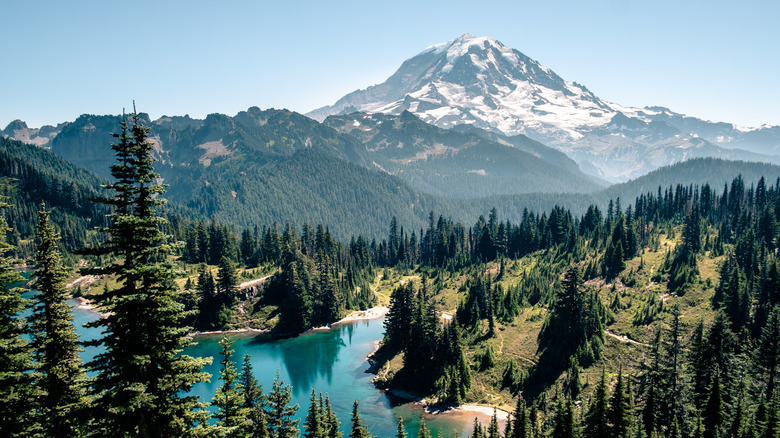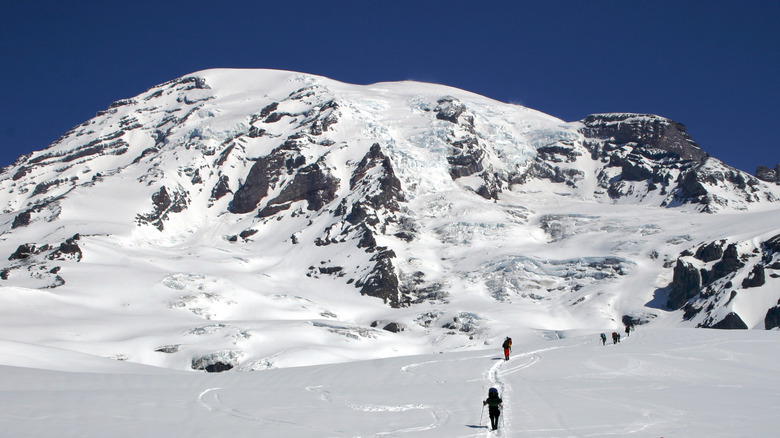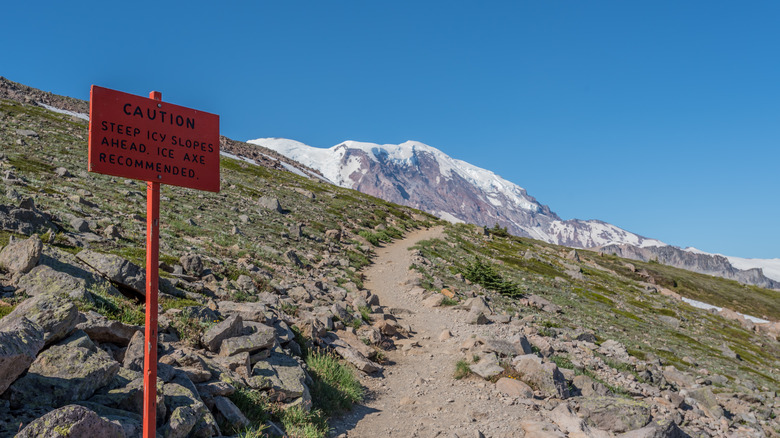Hike Up This Strenuous Trail For A Thrilling Mountainside Adventure
At 14,410 feet, Mt. Rainier is the tallest mountain not just in Washington state, but in all of the Cascade Range. The majestic, snowcapped peak is an iconic symbol of the Pacific Northwest, visible from up to 300 miles away in clear weather. The park that encircles the mountain, Mount Rainier National Park, is an outdoor-lover's playground, with turquoise lakes, rugged rock faces, cascading waterfalls, and massive glaciers. In addition, the park boasts 260 miles of hiking trails, including the popular yet extremely challenging and dangerous hike to Camp Muir.
The journey starts on the Skyline Trail, in dreamy wildflower meadows near the Paradise Visitor Center, and ends at snowy Camp Muir, often well above the clouds. Perched at an elevation of 10,188 feet above sea level, the camp offers stunning panoramic views of the surrounding area, including Mount St. Helens and Mount Adams in the distance. But views like these must be earned. This is a strenuous hike that requires a high level of fitness, adequate preparation, and a deep respect for the mountain.
Challenges of hiking to Camp Muir
The 9-mile round-trip hike typically takes between 8 and 10 hours, depending on your fitness level. While the length of the trail is manageable, the 4,788 feet of elevation gain is quite another story. As you ascend the steep trail in the thinning air, your legs start quaking. Each step seems to require more effort. You may also feel light-headed or even develop slight altitude sickness from the rapid change in elevation. Rubber legs and breathlessness combine with an unmistakable euphoria: You've now entered the place where hiking becomes mountaineering. Congratulations!
Aside from the trail's steepness, the terrain itself is also pretty tough. The last 2.2 miles of the route is a snowfield that seems to go on forever, interrupted only by an occasional lonely rock island. Staying on the route is extremely important in this section to avoid falling into crevasses hiding under the snow . The mountain is also something of a magician when it comes to the weather. One minute, you're peeling off your heavy jacket, and the next minute, a blizzard ensues. This volatility adds another layer of risk to the adventure, since whiteout conditions can make navigation even more difficult.
Training and preparation
Given these risks, it's crucial to be prepared when tackling the hike to Camp Muir. In the months before the adventure, build your endurance through regular cardiovascular exercise and strength training. On the day of the hike, be sure to bring what are known as the 10 essentials: a map and any navigation devices, a headlamp and extra batteries, sun protection, a first aid kit, a knife, matches or a lighter, a bivy sack or some kind of shelter, food, water, and extra clothing. Check the weather forecast before and during your hike, and be prepared to turn back if conditions deteriorate.
Take navigation very seriously on this hike. Study the map of the route beforehand and bring one with you on your hike, along with the requisite navigational devices. Lastly, respect the mountain: its mercurial climate, vast snowfields, and ever-shifting glaciers. If you find yourself more awed than irked by the scale of these challenges, you just might be a mountaineer.


